Detailed Analysis of Business Resources in Sainsbury's Operations
VerifiedAdded on 2020/01/21
|11
|2705
|50
Report
AI Summary
This report provides a comprehensive analysis of Sainsbury's business resources. It begins by examining the recruitment process, including documentation and the desired skills for a sales executive role, and then explores the physical and technological resources essential for the company's operations. The report delves into Sainsbury's financial sources, differentiating between internal and external funding, and interprets key elements from its financial statements, including an analysis of profitability margins, current ratios, and debt-to-equity ratios. Furthermore, the report includes an exercise in financial control, using a budget to determine break-even points and suggest remedial actions to avoid losses. The report concludes with an illustration of Sainsbury's financial statements, highlighting key performance indicators and providing a comparative analysis between 2015 and 2016. The analysis provides insights into the company's financial health, resource management, and operational strategies.
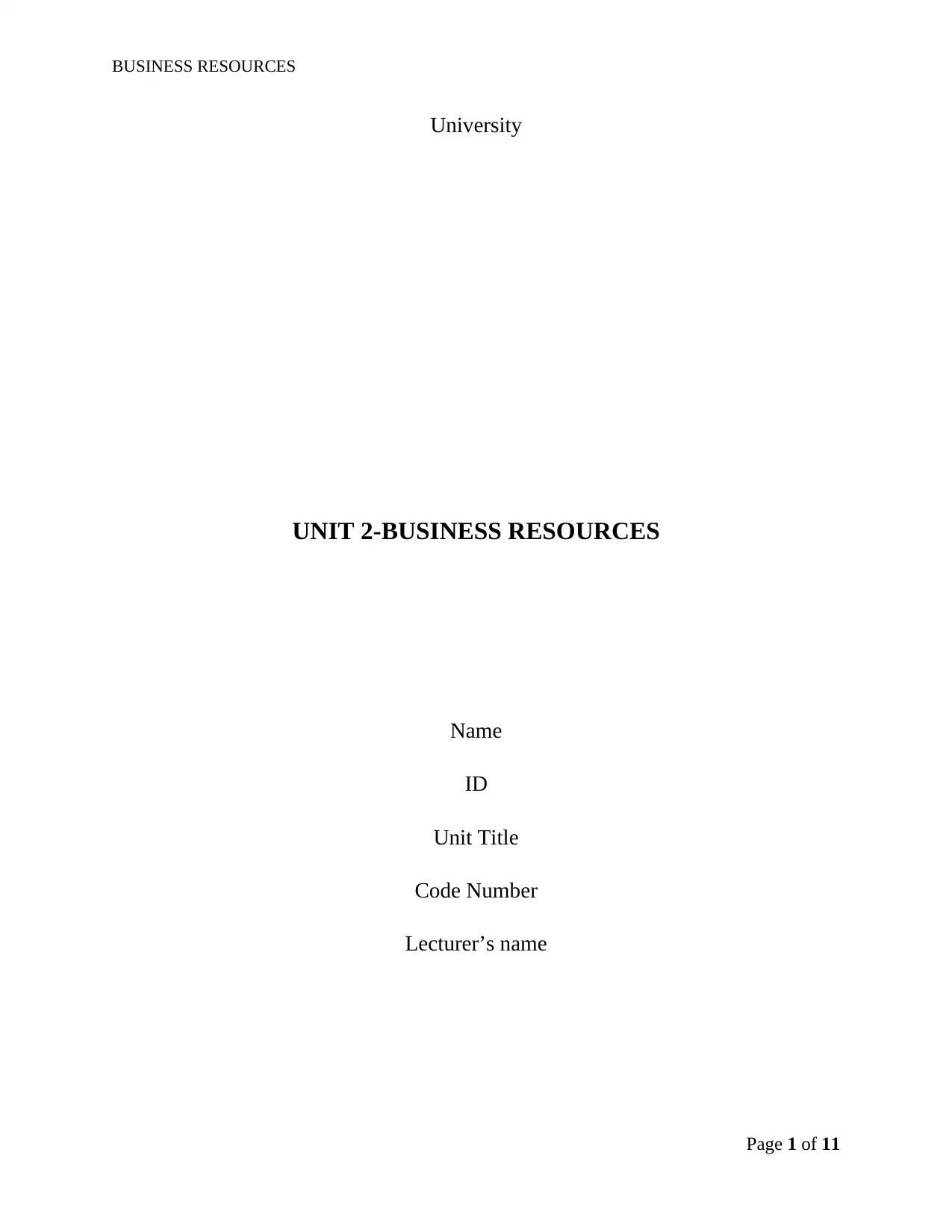
BUSINESS RESOURCES
University
UNIT 2-BUSINESS RESOURCES
Name
ID
Unit Title
Code Number
Lecturer’s name
Page 1 of 11
University
UNIT 2-BUSINESS RESOURCES
Name
ID
Unit Title
Code Number
Lecturer’s name
Page 1 of 11
Paraphrase This Document
Need a fresh take? Get an instant paraphrase of this document with our AI Paraphraser
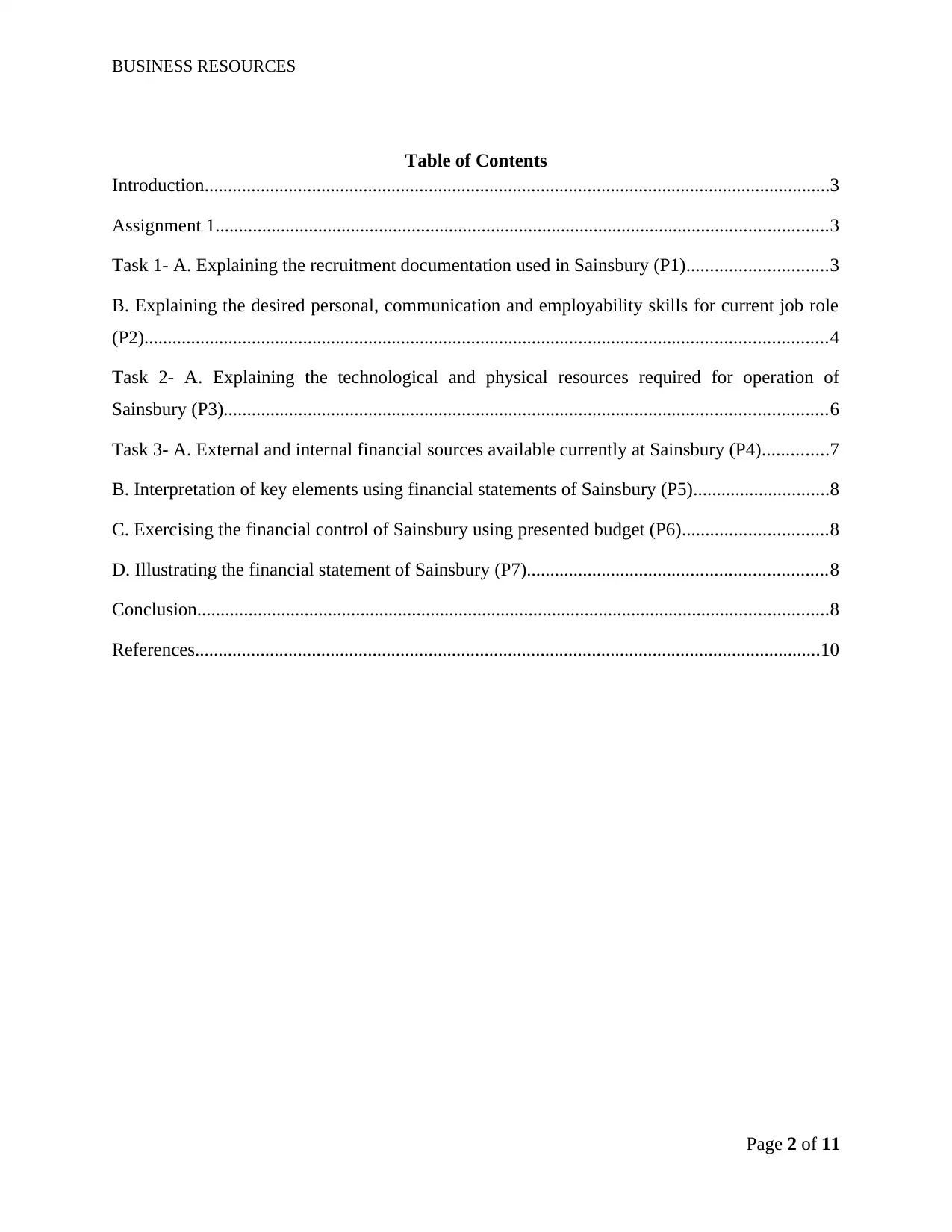
BUSINESS RESOURCES
Table of Contents
Introduction......................................................................................................................................3
Assignment 1...................................................................................................................................3
Task 1- A. Explaining the recruitment documentation used in Sainsbury (P1)..............................3
B. Explaining the desired personal, communication and employability skills for current job role
(P2)..................................................................................................................................................4
Task 2- A. Explaining the technological and physical resources required for operation of
Sainsbury (P3).................................................................................................................................6
Task 3- A. External and internal financial sources available currently at Sainsbury (P4)..............7
B. Interpretation of key elements using financial statements of Sainsbury (P5).............................8
C. Exercising the financial control of Sainsbury using presented budget (P6)...............................8
D. Illustrating the financial statement of Sainsbury (P7)................................................................8
Conclusion.......................................................................................................................................8
References......................................................................................................................................10
Page 2 of 11
Table of Contents
Introduction......................................................................................................................................3
Assignment 1...................................................................................................................................3
Task 1- A. Explaining the recruitment documentation used in Sainsbury (P1)..............................3
B. Explaining the desired personal, communication and employability skills for current job role
(P2)..................................................................................................................................................4
Task 2- A. Explaining the technological and physical resources required for operation of
Sainsbury (P3).................................................................................................................................6
Task 3- A. External and internal financial sources available currently at Sainsbury (P4)..............7
B. Interpretation of key elements using financial statements of Sainsbury (P5).............................8
C. Exercising the financial control of Sainsbury using presented budget (P6)...............................8
D. Illustrating the financial statement of Sainsbury (P7)................................................................8
Conclusion.......................................................................................................................................8
References......................................................................................................................................10
Page 2 of 11
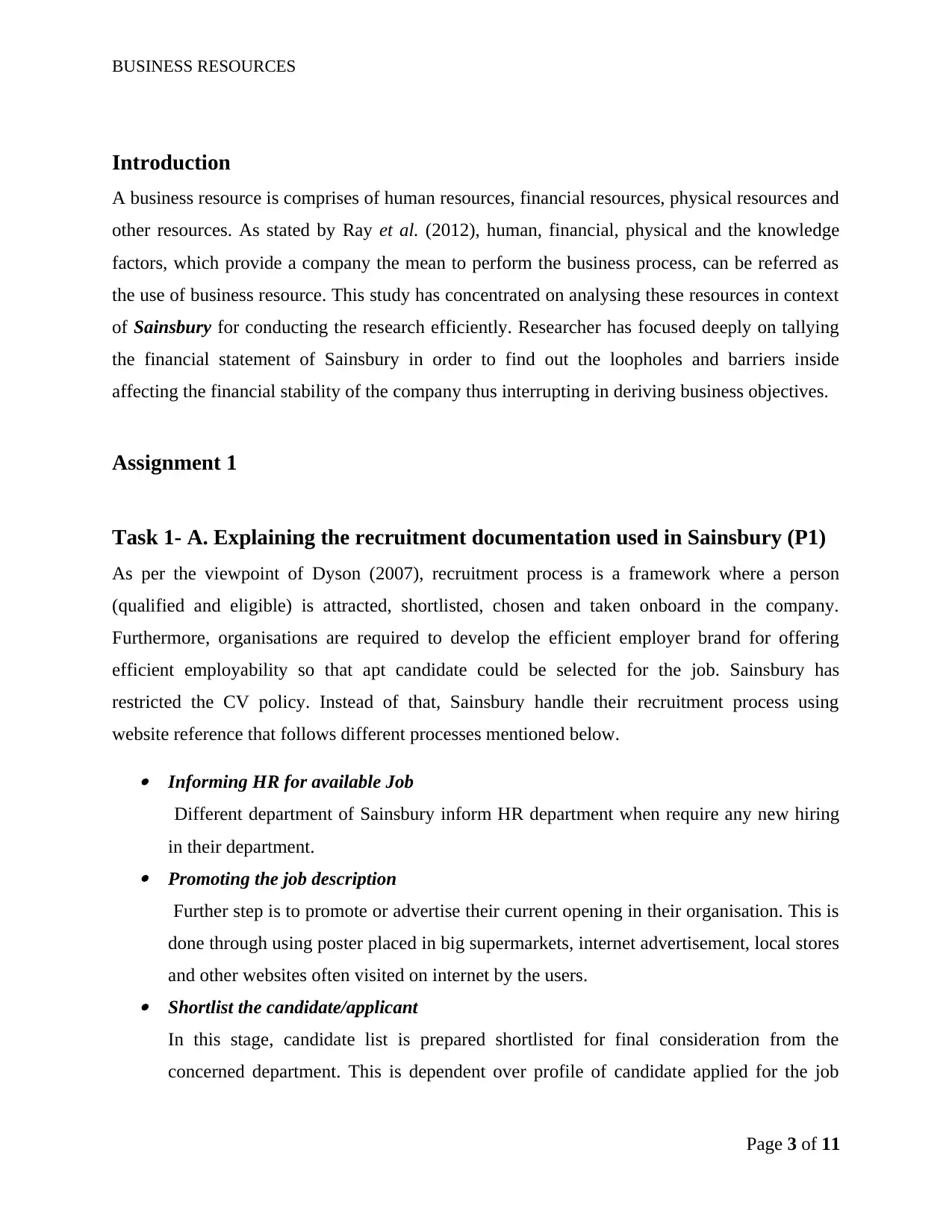
BUSINESS RESOURCES
Introduction
A business resource is comprises of human resources, financial resources, physical resources and
other resources. As stated by Ray et al. (2012), human, financial, physical and the knowledge
factors, which provide a company the mean to perform the business process, can be referred as
the use of business resource. This study has concentrated on analysing these resources in context
of Sainsbury for conducting the research efficiently. Researcher has focused deeply on tallying
the financial statement of Sainsbury in order to find out the loopholes and barriers inside
affecting the financial stability of the company thus interrupting in deriving business objectives.
Assignment 1
Task 1- A. Explaining the recruitment documentation used in Sainsbury (P1)
As per the viewpoint of Dyson (2007), recruitment process is a framework where a person
(qualified and eligible) is attracted, shortlisted, chosen and taken onboard in the company.
Furthermore, organisations are required to develop the efficient employer brand for offering
efficient employability so that apt candidate could be selected for the job. Sainsbury has
restricted the CV policy. Instead of that, Sainsbury handle their recruitment process using
website reference that follows different processes mentioned below.
Informing HR for available Job
Different department of Sainsbury inform HR department when require any new hiring
in their department. Promoting the job description
Further step is to promote or advertise their current opening in their organisation. This is
done through using poster placed in big supermarkets, internet advertisement, local stores
and other websites often visited on internet by the users. Shortlist the candidate/applicant
In this stage, candidate list is prepared shortlisted for final consideration from the
concerned department. This is dependent over profile of candidate applied for the job
Page 3 of 11
Introduction
A business resource is comprises of human resources, financial resources, physical resources and
other resources. As stated by Ray et al. (2012), human, financial, physical and the knowledge
factors, which provide a company the mean to perform the business process, can be referred as
the use of business resource. This study has concentrated on analysing these resources in context
of Sainsbury for conducting the research efficiently. Researcher has focused deeply on tallying
the financial statement of Sainsbury in order to find out the loopholes and barriers inside
affecting the financial stability of the company thus interrupting in deriving business objectives.
Assignment 1
Task 1- A. Explaining the recruitment documentation used in Sainsbury (P1)
As per the viewpoint of Dyson (2007), recruitment process is a framework where a person
(qualified and eligible) is attracted, shortlisted, chosen and taken onboard in the company.
Furthermore, organisations are required to develop the efficient employer brand for offering
efficient employability so that apt candidate could be selected for the job. Sainsbury has
restricted the CV policy. Instead of that, Sainsbury handle their recruitment process using
website reference that follows different processes mentioned below.
Informing HR for available Job
Different department of Sainsbury inform HR department when require any new hiring
in their department. Promoting the job description
Further step is to promote or advertise their current opening in their organisation. This is
done through using poster placed in big supermarkets, internet advertisement, local stores
and other websites often visited on internet by the users. Shortlist the candidate/applicant
In this stage, candidate list is prepared shortlisted for final consideration from the
concerned department. This is dependent over profile of candidate applied for the job
Page 3 of 11
⊘ This is a preview!⊘
Do you want full access?
Subscribe today to unlock all pages.

Trusted by 1+ million students worldwide
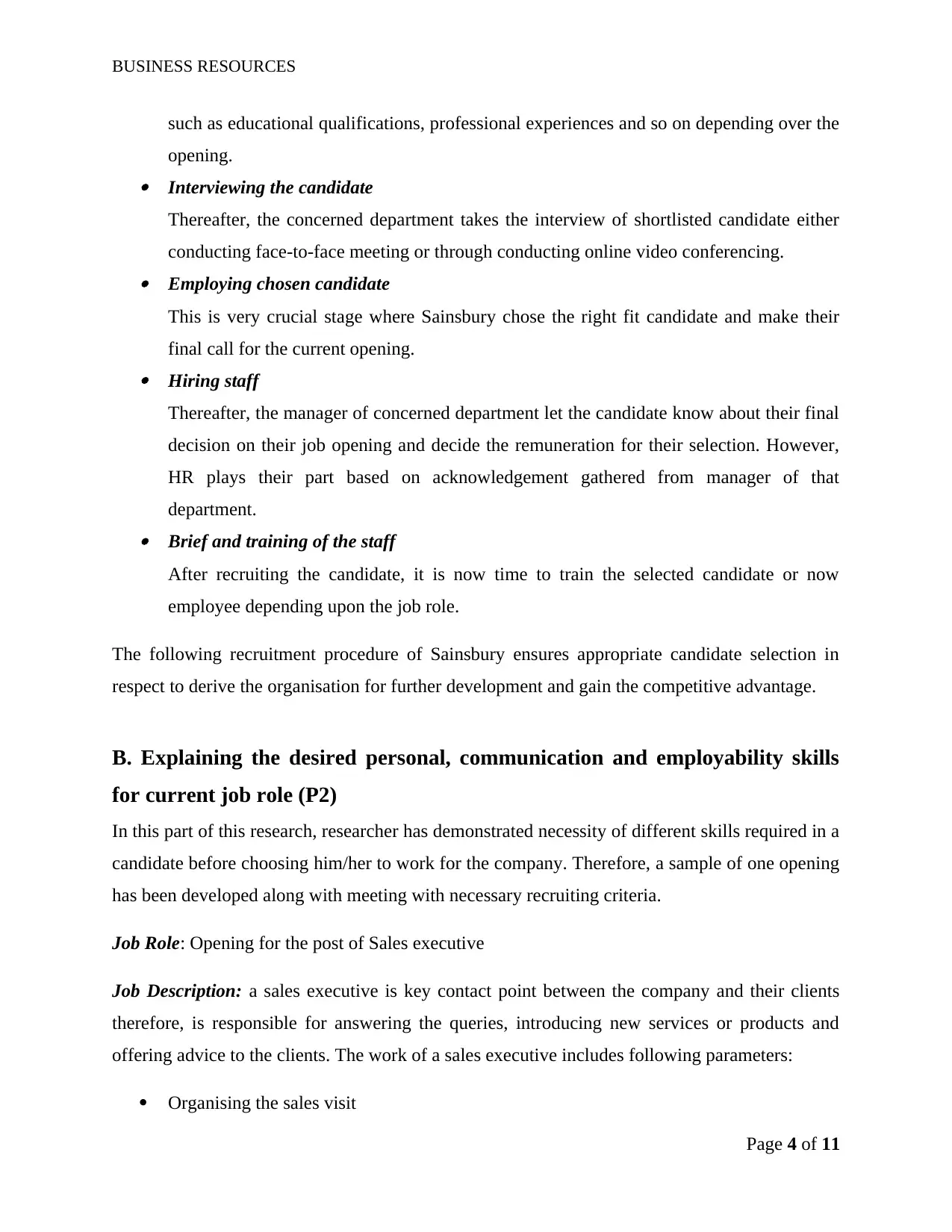
BUSINESS RESOURCES
such as educational qualifications, professional experiences and so on depending over the
opening. Interviewing the candidate
Thereafter, the concerned department takes the interview of shortlisted candidate either
conducting face-to-face meeting or through conducting online video conferencing. Employing chosen candidate
This is very crucial stage where Sainsbury chose the right fit candidate and make their
final call for the current opening. Hiring staff
Thereafter, the manager of concerned department let the candidate know about their final
decision on their job opening and decide the remuneration for their selection. However,
HR plays their part based on acknowledgement gathered from manager of that
department. Brief and training of the staff
After recruiting the candidate, it is now time to train the selected candidate or now
employee depending upon the job role.
The following recruitment procedure of Sainsbury ensures appropriate candidate selection in
respect to derive the organisation for further development and gain the competitive advantage.
B. Explaining the desired personal, communication and employability skills
for current job role (P2)
In this part of this research, researcher has demonstrated necessity of different skills required in a
candidate before choosing him/her to work for the company. Therefore, a sample of one opening
has been developed along with meeting with necessary recruiting criteria.
Job Role: Opening for the post of Sales executive
Job Description: a sales executive is key contact point between the company and their clients
therefore, is responsible for answering the queries, introducing new services or products and
offering advice to the clients. The work of a sales executive includes following parameters:
Organising the sales visit
Page 4 of 11
such as educational qualifications, professional experiences and so on depending over the
opening. Interviewing the candidate
Thereafter, the concerned department takes the interview of shortlisted candidate either
conducting face-to-face meeting or through conducting online video conferencing. Employing chosen candidate
This is very crucial stage where Sainsbury chose the right fit candidate and make their
final call for the current opening. Hiring staff
Thereafter, the manager of concerned department let the candidate know about their final
decision on their job opening and decide the remuneration for their selection. However,
HR plays their part based on acknowledgement gathered from manager of that
department. Brief and training of the staff
After recruiting the candidate, it is now time to train the selected candidate or now
employee depending upon the job role.
The following recruitment procedure of Sainsbury ensures appropriate candidate selection in
respect to derive the organisation for further development and gain the competitive advantage.
B. Explaining the desired personal, communication and employability skills
for current job role (P2)
In this part of this research, researcher has demonstrated necessity of different skills required in a
candidate before choosing him/her to work for the company. Therefore, a sample of one opening
has been developed along with meeting with necessary recruiting criteria.
Job Role: Opening for the post of Sales executive
Job Description: a sales executive is key contact point between the company and their clients
therefore, is responsible for answering the queries, introducing new services or products and
offering advice to the clients. The work of a sales executive includes following parameters:
Organising the sales visit
Page 4 of 11
Paraphrase This Document
Need a fresh take? Get an instant paraphrase of this document with our AI Paraphraser
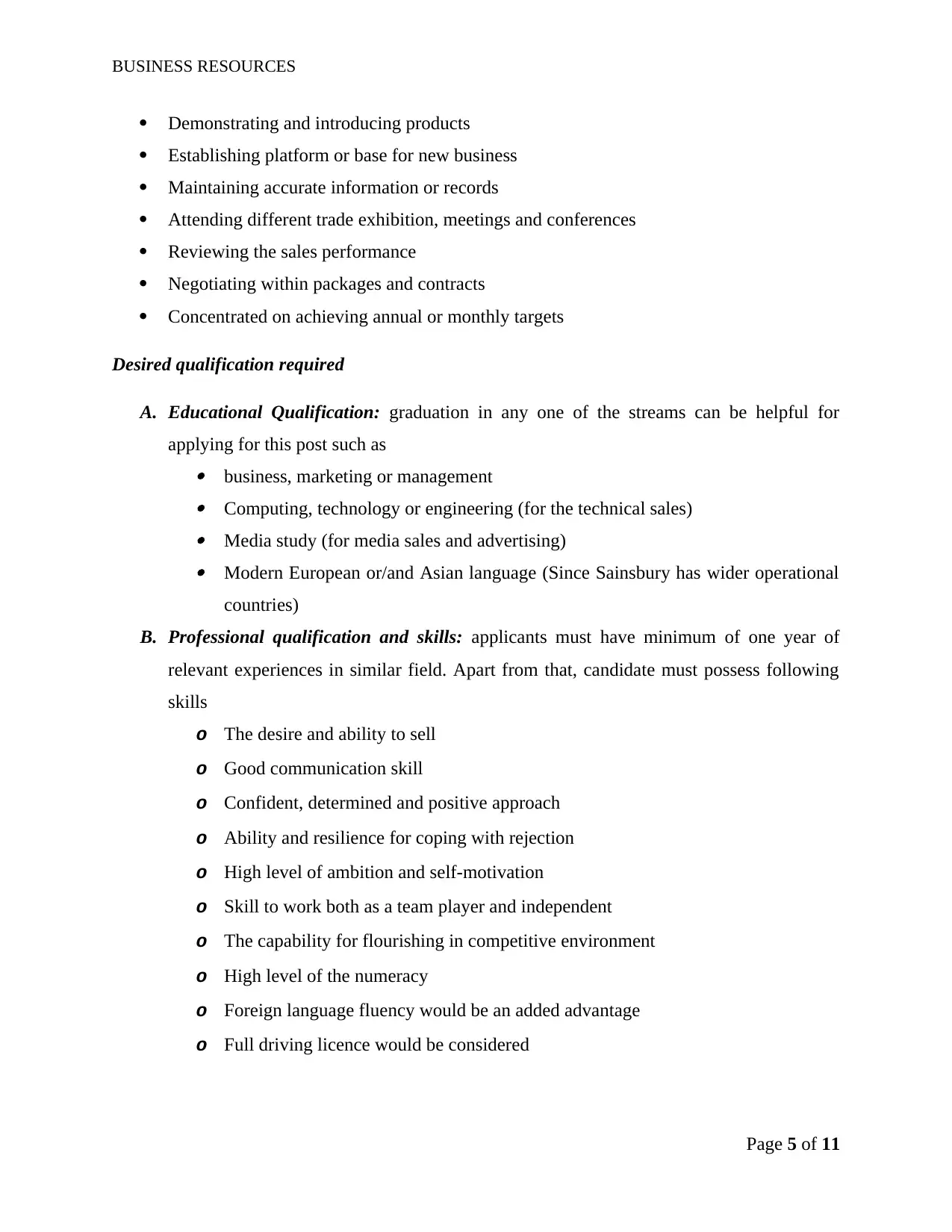
BUSINESS RESOURCES
Demonstrating and introducing products
Establishing platform or base for new business
Maintaining accurate information or records
Attending different trade exhibition, meetings and conferences
Reviewing the sales performance
Negotiating within packages and contracts
Concentrated on achieving annual or monthly targets
Desired qualification required
A. Educational Qualification: graduation in any one of the streams can be helpful for
applying for this post such as
business, marketing or management
Computing, technology or engineering (for the technical sales)
Media study (for media sales and advertising)
Modern European or/and Asian language (Since Sainsbury has wider operational
countries)
B. Professional qualification and skills: applicants must have minimum of one year of
relevant experiences in similar field. Apart from that, candidate must possess following
skills
o The desire and ability to sell
o Good communication skill
o Confident, determined and positive approach
o Ability and resilience for coping with rejection
o High level of ambition and self-motivation
o Skill to work both as a team player and independent
o The capability for flourishing in competitive environment
o High level of the numeracy
o Foreign language fluency would be an added advantage
o Full driving licence would be considered
Page 5 of 11
Demonstrating and introducing products
Establishing platform or base for new business
Maintaining accurate information or records
Attending different trade exhibition, meetings and conferences
Reviewing the sales performance
Negotiating within packages and contracts
Concentrated on achieving annual or monthly targets
Desired qualification required
A. Educational Qualification: graduation in any one of the streams can be helpful for
applying for this post such as
business, marketing or management
Computing, technology or engineering (for the technical sales)
Media study (for media sales and advertising)
Modern European or/and Asian language (Since Sainsbury has wider operational
countries)
B. Professional qualification and skills: applicants must have minimum of one year of
relevant experiences in similar field. Apart from that, candidate must possess following
skills
o The desire and ability to sell
o Good communication skill
o Confident, determined and positive approach
o Ability and resilience for coping with rejection
o High level of ambition and self-motivation
o Skill to work both as a team player and independent
o The capability for flourishing in competitive environment
o High level of the numeracy
o Foreign language fluency would be an added advantage
o Full driving licence would be considered
Page 5 of 11
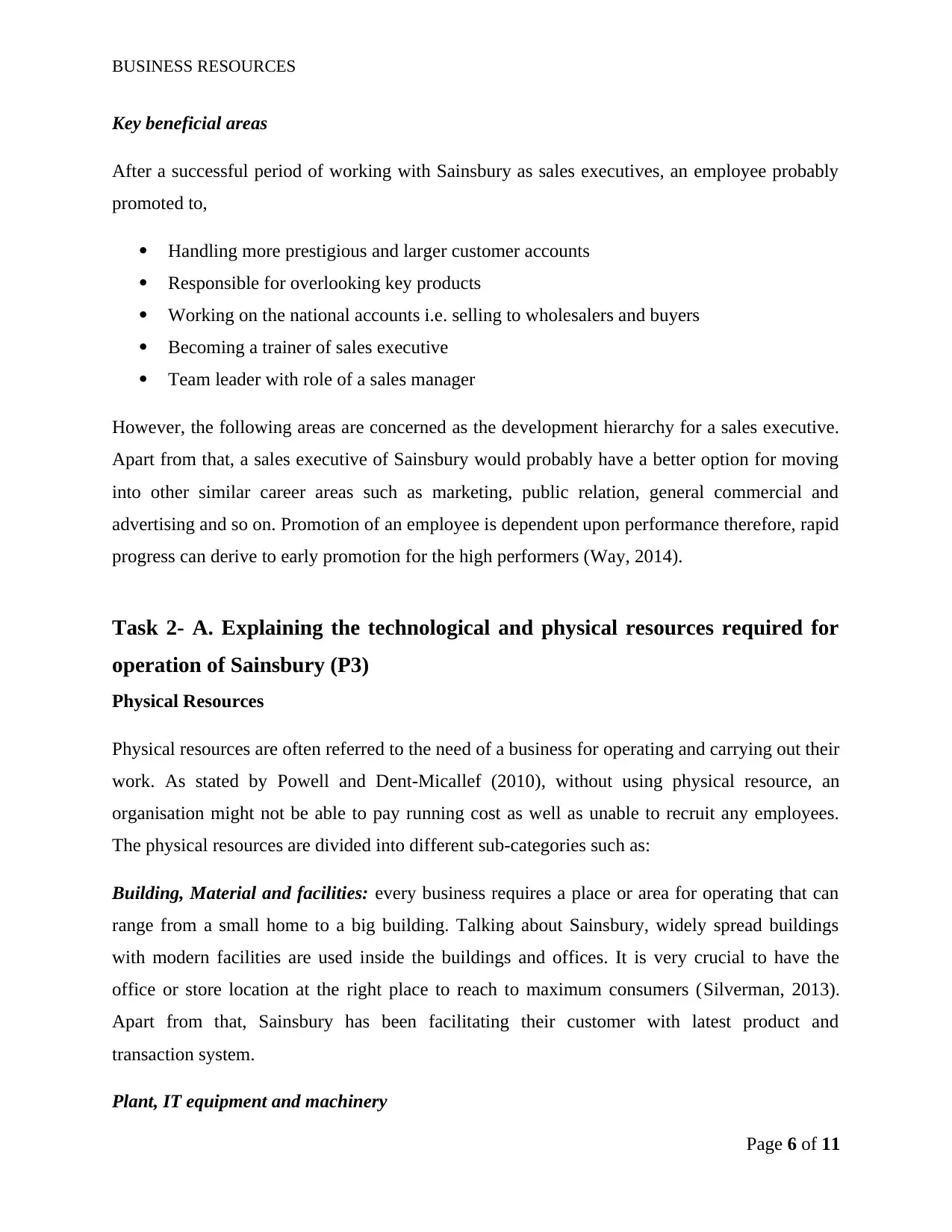
BUSINESS RESOURCES
Key beneficial areas
After a successful period of working with Sainsbury as sales executives, an employee probably
promoted to,
Handling more prestigious and larger customer accounts
Responsible for overlooking key products
Working on the national accounts i.e. selling to wholesalers and buyers
Becoming a trainer of sales executive
Team leader with role of a sales manager
However, the following areas are concerned as the development hierarchy for a sales executive.
Apart from that, a sales executive of Sainsbury would probably have a better option for moving
into other similar career areas such as marketing, public relation, general commercial and
advertising and so on. Promotion of an employee is dependent upon performance therefore, rapid
progress can derive to early promotion for the high performers (Way, 2014).
Task 2- A. Explaining the technological and physical resources required for
operation of Sainsbury (P3)
Physical Resources
Physical resources are often referred to the need of a business for operating and carrying out their
work. As stated by Powell and Dent-Micallef (2010), without using physical resource, an
organisation might not be able to pay running cost as well as unable to recruit any employees.
The physical resources are divided into different sub-categories such as:
Building, Material and facilities: every business requires a place or area for operating that can
range from a small home to a big building. Talking about Sainsbury, widely spread buildings
with modern facilities are used inside the buildings and offices. It is very crucial to have the
office or store location at the right place to reach to maximum consumers (Silverman, 2013).
Apart from that, Sainsbury has been facilitating their customer with latest product and
transaction system.
Plant, IT equipment and machinery
Page 6 of 11
Key beneficial areas
After a successful period of working with Sainsbury as sales executives, an employee probably
promoted to,
Handling more prestigious and larger customer accounts
Responsible for overlooking key products
Working on the national accounts i.e. selling to wholesalers and buyers
Becoming a trainer of sales executive
Team leader with role of a sales manager
However, the following areas are concerned as the development hierarchy for a sales executive.
Apart from that, a sales executive of Sainsbury would probably have a better option for moving
into other similar career areas such as marketing, public relation, general commercial and
advertising and so on. Promotion of an employee is dependent upon performance therefore, rapid
progress can derive to early promotion for the high performers (Way, 2014).
Task 2- A. Explaining the technological and physical resources required for
operation of Sainsbury (P3)
Physical Resources
Physical resources are often referred to the need of a business for operating and carrying out their
work. As stated by Powell and Dent-Micallef (2010), without using physical resource, an
organisation might not be able to pay running cost as well as unable to recruit any employees.
The physical resources are divided into different sub-categories such as:
Building, Material and facilities: every business requires a place or area for operating that can
range from a small home to a big building. Talking about Sainsbury, widely spread buildings
with modern facilities are used inside the buildings and offices. It is very crucial to have the
office or store location at the right place to reach to maximum consumers (Silverman, 2013).
Apart from that, Sainsbury has been facilitating their customer with latest product and
transaction system.
Plant, IT equipment and machinery
Page 6 of 11
⊘ This is a preview!⊘
Do you want full access?
Subscribe today to unlock all pages.

Trusted by 1+ million students worldwide
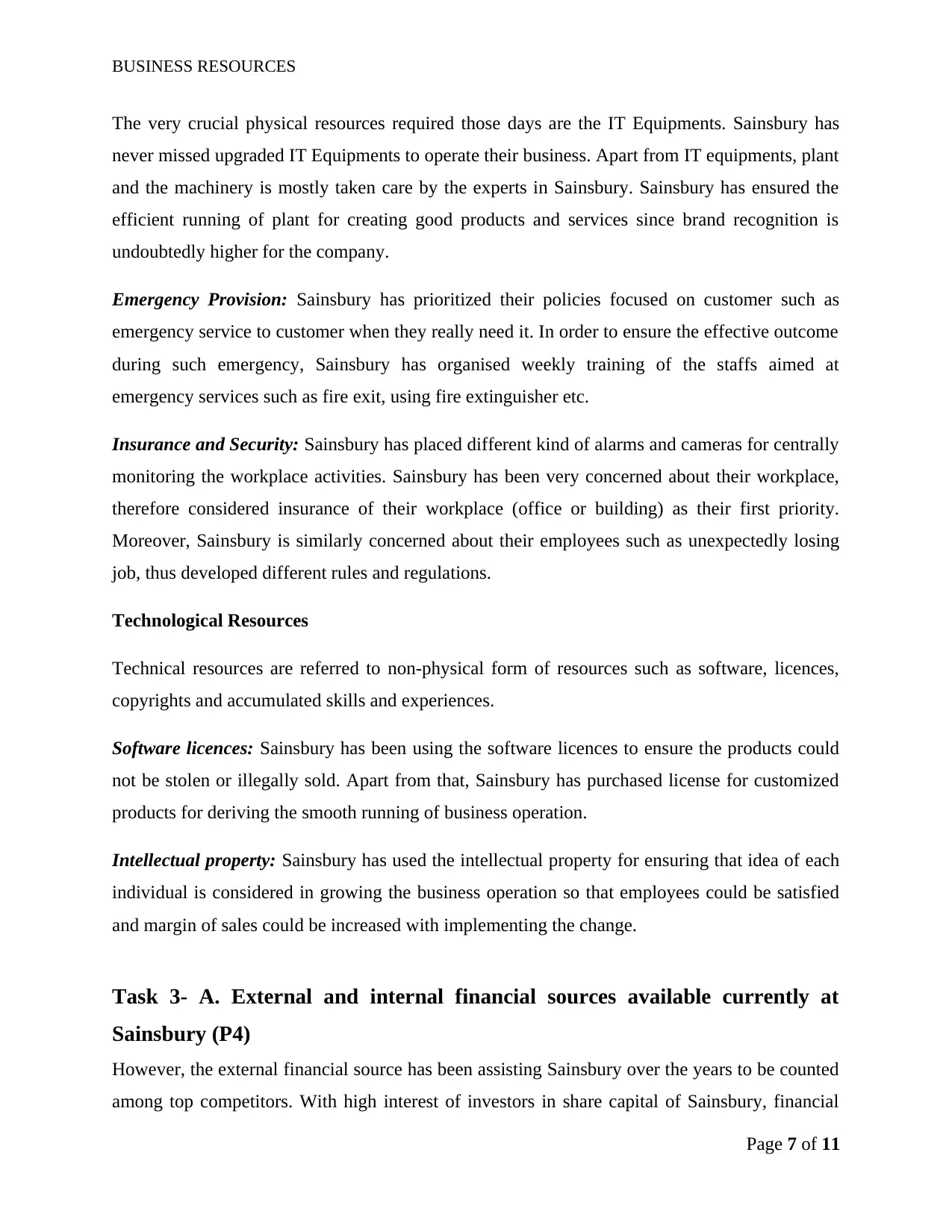
BUSINESS RESOURCES
The very crucial physical resources required those days are the IT Equipments. Sainsbury has
never missed upgraded IT Equipments to operate their business. Apart from IT equipments, plant
and the machinery is mostly taken care by the experts in Sainsbury. Sainsbury has ensured the
efficient running of plant for creating good products and services since brand recognition is
undoubtedly higher for the company.
Emergency Provision: Sainsbury has prioritized their policies focused on customer such as
emergency service to customer when they really need it. In order to ensure the effective outcome
during such emergency, Sainsbury has organised weekly training of the staffs aimed at
emergency services such as fire exit, using fire extinguisher etc.
Insurance and Security: Sainsbury has placed different kind of alarms and cameras for centrally
monitoring the workplace activities. Sainsbury has been very concerned about their workplace,
therefore considered insurance of their workplace (office or building) as their first priority.
Moreover, Sainsbury is similarly concerned about their employees such as unexpectedly losing
job, thus developed different rules and regulations.
Technological Resources
Technical resources are referred to non-physical form of resources such as software, licences,
copyrights and accumulated skills and experiences.
Software licences: Sainsbury has been using the software licences to ensure the products could
not be stolen or illegally sold. Apart from that, Sainsbury has purchased license for customized
products for deriving the smooth running of business operation.
Intellectual property: Sainsbury has used the intellectual property for ensuring that idea of each
individual is considered in growing the business operation so that employees could be satisfied
and margin of sales could be increased with implementing the change.
Task 3- A. External and internal financial sources available currently at
Sainsbury (P4)
However, the external financial source has been assisting Sainsbury over the years to be counted
among top competitors. With high interest of investors in share capital of Sainsbury, financial
Page 7 of 11
The very crucial physical resources required those days are the IT Equipments. Sainsbury has
never missed upgraded IT Equipments to operate their business. Apart from IT equipments, plant
and the machinery is mostly taken care by the experts in Sainsbury. Sainsbury has ensured the
efficient running of plant for creating good products and services since brand recognition is
undoubtedly higher for the company.
Emergency Provision: Sainsbury has prioritized their policies focused on customer such as
emergency service to customer when they really need it. In order to ensure the effective outcome
during such emergency, Sainsbury has organised weekly training of the staffs aimed at
emergency services such as fire exit, using fire extinguisher etc.
Insurance and Security: Sainsbury has placed different kind of alarms and cameras for centrally
monitoring the workplace activities. Sainsbury has been very concerned about their workplace,
therefore considered insurance of their workplace (office or building) as their first priority.
Moreover, Sainsbury is similarly concerned about their employees such as unexpectedly losing
job, thus developed different rules and regulations.
Technological Resources
Technical resources are referred to non-physical form of resources such as software, licences,
copyrights and accumulated skills and experiences.
Software licences: Sainsbury has been using the software licences to ensure the products could
not be stolen or illegally sold. Apart from that, Sainsbury has purchased license for customized
products for deriving the smooth running of business operation.
Intellectual property: Sainsbury has used the intellectual property for ensuring that idea of each
individual is considered in growing the business operation so that employees could be satisfied
and margin of sales could be increased with implementing the change.
Task 3- A. External and internal financial sources available currently at
Sainsbury (P4)
However, the external financial source has been assisting Sainsbury over the years to be counted
among top competitors. With high interest of investors in share capital of Sainsbury, financial
Page 7 of 11
Paraphrase This Document
Need a fresh take? Get an instant paraphrase of this document with our AI Paraphraser
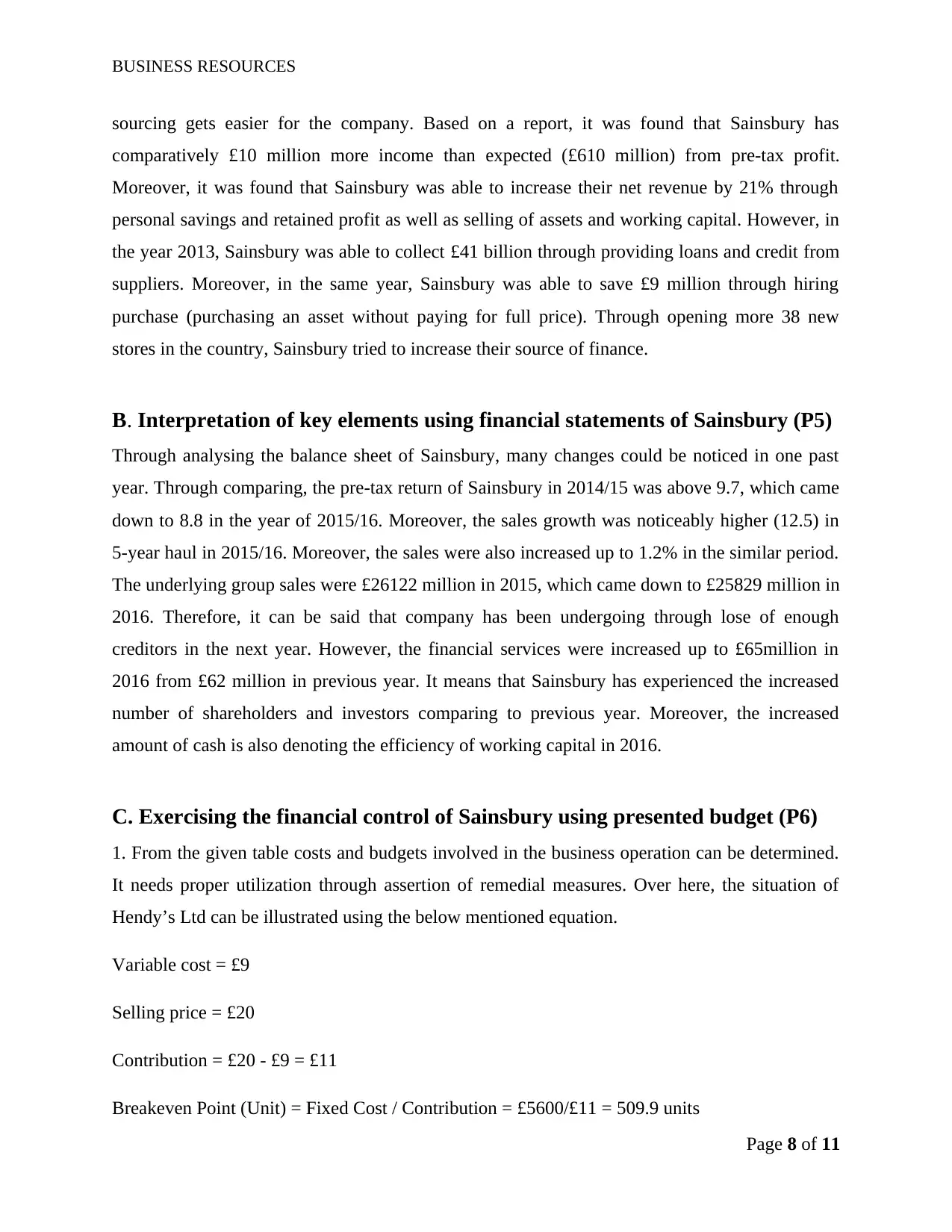
BUSINESS RESOURCES
sourcing gets easier for the company. Based on a report, it was found that Sainsbury has
comparatively £10 million more income than expected (£610 million) from pre-tax profit.
Moreover, it was found that Sainsbury was able to increase their net revenue by 21% through
personal savings and retained profit as well as selling of assets and working capital. However, in
the year 2013, Sainsbury was able to collect £41 billion through providing loans and credit from
suppliers. Moreover, in the same year, Sainsbury was able to save £9 million through hiring
purchase (purchasing an asset without paying for full price). Through opening more 38 new
stores in the country, Sainsbury tried to increase their source of finance.
B. Interpretation of key elements using financial statements of Sainsbury (P5)
Through analysing the balance sheet of Sainsbury, many changes could be noticed in one past
year. Through comparing, the pre-tax return of Sainsbury in 2014/15 was above 9.7, which came
down to 8.8 in the year of 2015/16. Moreover, the sales growth was noticeably higher (12.5) in
5-year haul in 2015/16. Moreover, the sales were also increased up to 1.2% in the similar period.
The underlying group sales were £26122 million in 2015, which came down to £25829 million in
2016. Therefore, it can be said that company has been undergoing through lose of enough
creditors in the next year. However, the financial services were increased up to £65million in
2016 from £62 million in previous year. It means that Sainsbury has experienced the increased
number of shareholders and investors comparing to previous year. Moreover, the increased
amount of cash is also denoting the efficiency of working capital in 2016.
C. Exercising the financial control of Sainsbury using presented budget (P6)
1. From the given table costs and budgets involved in the business operation can be determined.
It needs proper utilization through assertion of remedial measures. Over here, the situation of
Hendy’s Ltd can be illustrated using the below mentioned equation.
Variable cost = £9
Selling price = £20
Contribution = £20 - £9 = £11
Breakeven Point (Unit) = Fixed Cost / Contribution = £5600/£11 = 509.9 units
Page 8 of 11
sourcing gets easier for the company. Based on a report, it was found that Sainsbury has
comparatively £10 million more income than expected (£610 million) from pre-tax profit.
Moreover, it was found that Sainsbury was able to increase their net revenue by 21% through
personal savings and retained profit as well as selling of assets and working capital. However, in
the year 2013, Sainsbury was able to collect £41 billion through providing loans and credit from
suppliers. Moreover, in the same year, Sainsbury was able to save £9 million through hiring
purchase (purchasing an asset without paying for full price). Through opening more 38 new
stores in the country, Sainsbury tried to increase their source of finance.
B. Interpretation of key elements using financial statements of Sainsbury (P5)
Through analysing the balance sheet of Sainsbury, many changes could be noticed in one past
year. Through comparing, the pre-tax return of Sainsbury in 2014/15 was above 9.7, which came
down to 8.8 in the year of 2015/16. Moreover, the sales growth was noticeably higher (12.5) in
5-year haul in 2015/16. Moreover, the sales were also increased up to 1.2% in the similar period.
The underlying group sales were £26122 million in 2015, which came down to £25829 million in
2016. Therefore, it can be said that company has been undergoing through lose of enough
creditors in the next year. However, the financial services were increased up to £65million in
2016 from £62 million in previous year. It means that Sainsbury has experienced the increased
number of shareholders and investors comparing to previous year. Moreover, the increased
amount of cash is also denoting the efficiency of working capital in 2016.
C. Exercising the financial control of Sainsbury using presented budget (P6)
1. From the given table costs and budgets involved in the business operation can be determined.
It needs proper utilization through assertion of remedial measures. Over here, the situation of
Hendy’s Ltd can be illustrated using the below mentioned equation.
Variable cost = £9
Selling price = £20
Contribution = £20 - £9 = £11
Breakeven Point (Unit) = Fixed Cost / Contribution = £5600/£11 = 509.9 units
Page 8 of 11
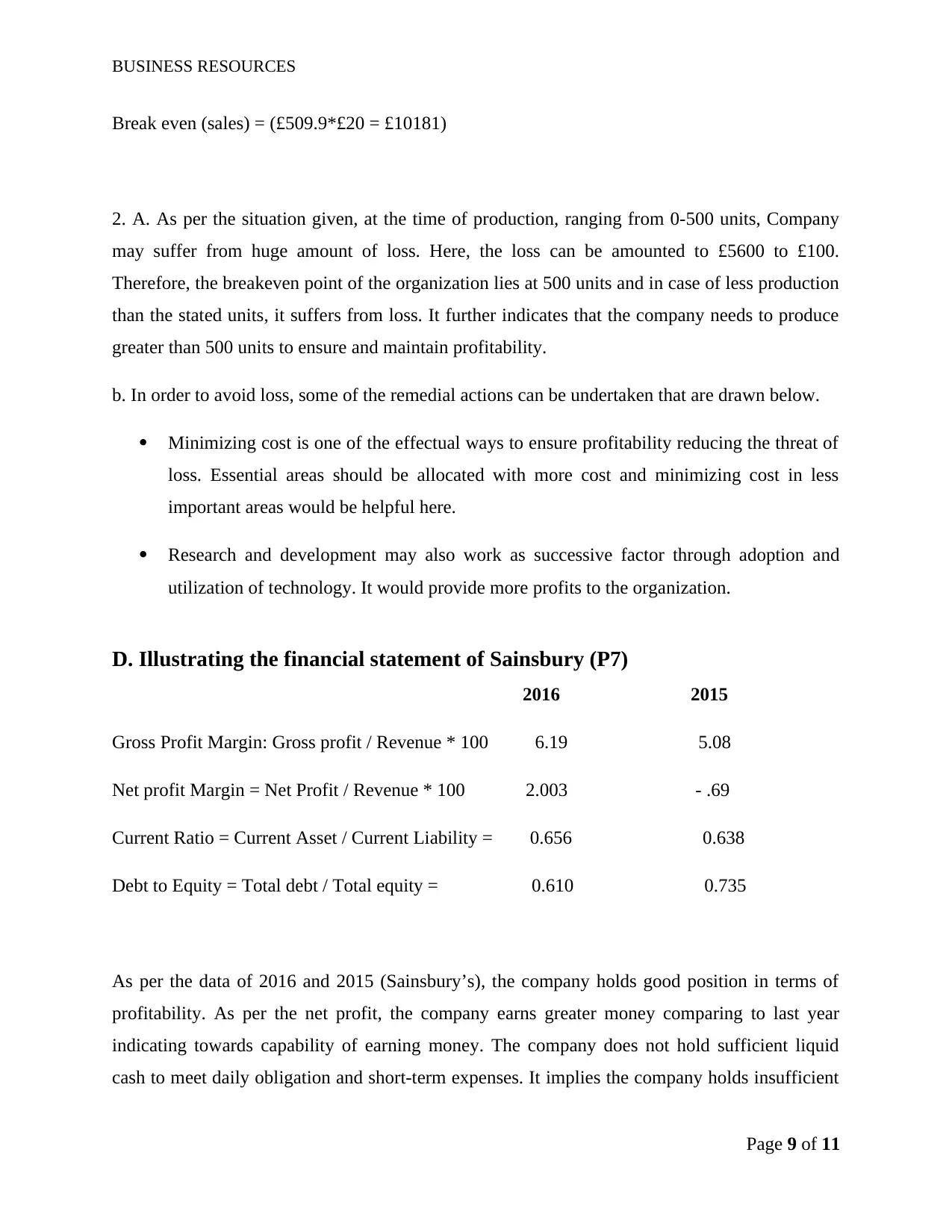
BUSINESS RESOURCES
Break even (sales) = (£509.9*£20 = £10181)
2. A. As per the situation given, at the time of production, ranging from 0-500 units, Company
may suffer from huge amount of loss. Here, the loss can be amounted to £5600 to £100.
Therefore, the breakeven point of the organization lies at 500 units and in case of less production
than the stated units, it suffers from loss. It further indicates that the company needs to produce
greater than 500 units to ensure and maintain profitability.
b. In order to avoid loss, some of the remedial actions can be undertaken that are drawn below.
Minimizing cost is one of the effectual ways to ensure profitability reducing the threat of
loss. Essential areas should be allocated with more cost and minimizing cost in less
important areas would be helpful here.
Research and development may also work as successive factor through adoption and
utilization of technology. It would provide more profits to the organization.
D. Illustrating the financial statement of Sainsbury (P7)
2016 2015
Gross Profit Margin: Gross profit / Revenue * 100 6.19 5.08
Net profit Margin = Net Profit / Revenue * 100 2.003 - .69
Current Ratio = Current Asset / Current Liability = 0.656 0.638
Debt to Equity = Total debt / Total equity = 0.610 0.735
As per the data of 2016 and 2015 (Sainsbury’s), the company holds good position in terms of
profitability. As per the net profit, the company earns greater money comparing to last year
indicating towards capability of earning money. The company does not hold sufficient liquid
cash to meet daily obligation and short-term expenses. It implies the company holds insufficient
Page 9 of 11
Break even (sales) = (£509.9*£20 = £10181)
2. A. As per the situation given, at the time of production, ranging from 0-500 units, Company
may suffer from huge amount of loss. Here, the loss can be amounted to £5600 to £100.
Therefore, the breakeven point of the organization lies at 500 units and in case of less production
than the stated units, it suffers from loss. It further indicates that the company needs to produce
greater than 500 units to ensure and maintain profitability.
b. In order to avoid loss, some of the remedial actions can be undertaken that are drawn below.
Minimizing cost is one of the effectual ways to ensure profitability reducing the threat of
loss. Essential areas should be allocated with more cost and minimizing cost in less
important areas would be helpful here.
Research and development may also work as successive factor through adoption and
utilization of technology. It would provide more profits to the organization.
D. Illustrating the financial statement of Sainsbury (P7)
2016 2015
Gross Profit Margin: Gross profit / Revenue * 100 6.19 5.08
Net profit Margin = Net Profit / Revenue * 100 2.003 - .69
Current Ratio = Current Asset / Current Liability = 0.656 0.638
Debt to Equity = Total debt / Total equity = 0.610 0.735
As per the data of 2016 and 2015 (Sainsbury’s), the company holds good position in terms of
profitability. As per the net profit, the company earns greater money comparing to last year
indicating towards capability of earning money. The company does not hold sufficient liquid
cash to meet daily obligation and short-term expenses. It implies the company holds insufficient
Page 9 of 11
⊘ This is a preview!⊘
Do you want full access?
Subscribe today to unlock all pages.

Trusted by 1+ million students worldwide
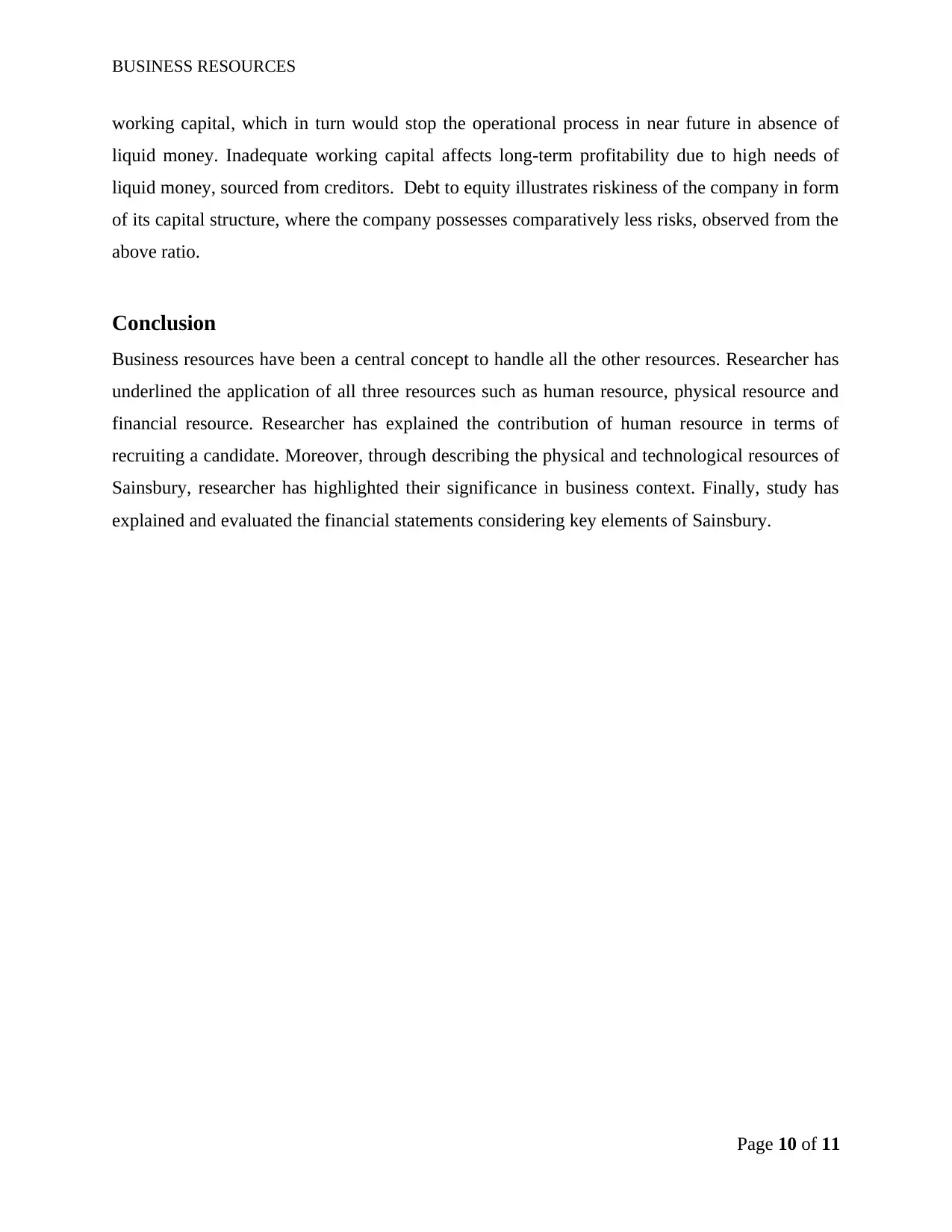
BUSINESS RESOURCES
working capital, which in turn would stop the operational process in near future in absence of
liquid money. Inadequate working capital affects long-term profitability due to high needs of
liquid money, sourced from creditors. Debt to equity illustrates riskiness of the company in form
of its capital structure, where the company possesses comparatively less risks, observed from the
above ratio.
Conclusion
Business resources have been a central concept to handle all the other resources. Researcher has
underlined the application of all three resources such as human resource, physical resource and
financial resource. Researcher has explained the contribution of human resource in terms of
recruiting a candidate. Moreover, through describing the physical and technological resources of
Sainsbury, researcher has highlighted their significance in business context. Finally, study has
explained and evaluated the financial statements considering key elements of Sainsbury.
Page 10 of 11
working capital, which in turn would stop the operational process in near future in absence of
liquid money. Inadequate working capital affects long-term profitability due to high needs of
liquid money, sourced from creditors. Debt to equity illustrates riskiness of the company in form
of its capital structure, where the company possesses comparatively less risks, observed from the
above ratio.
Conclusion
Business resources have been a central concept to handle all the other resources. Researcher has
underlined the application of all three resources such as human resource, physical resource and
financial resource. Researcher has explained the contribution of human resource in terms of
recruiting a candidate. Moreover, through describing the physical and technological resources of
Sainsbury, researcher has highlighted their significance in business context. Finally, study has
explained and evaluated the financial statements considering key elements of Sainsbury.
Page 10 of 11
Paraphrase This Document
Need a fresh take? Get an instant paraphrase of this document with our AI Paraphraser
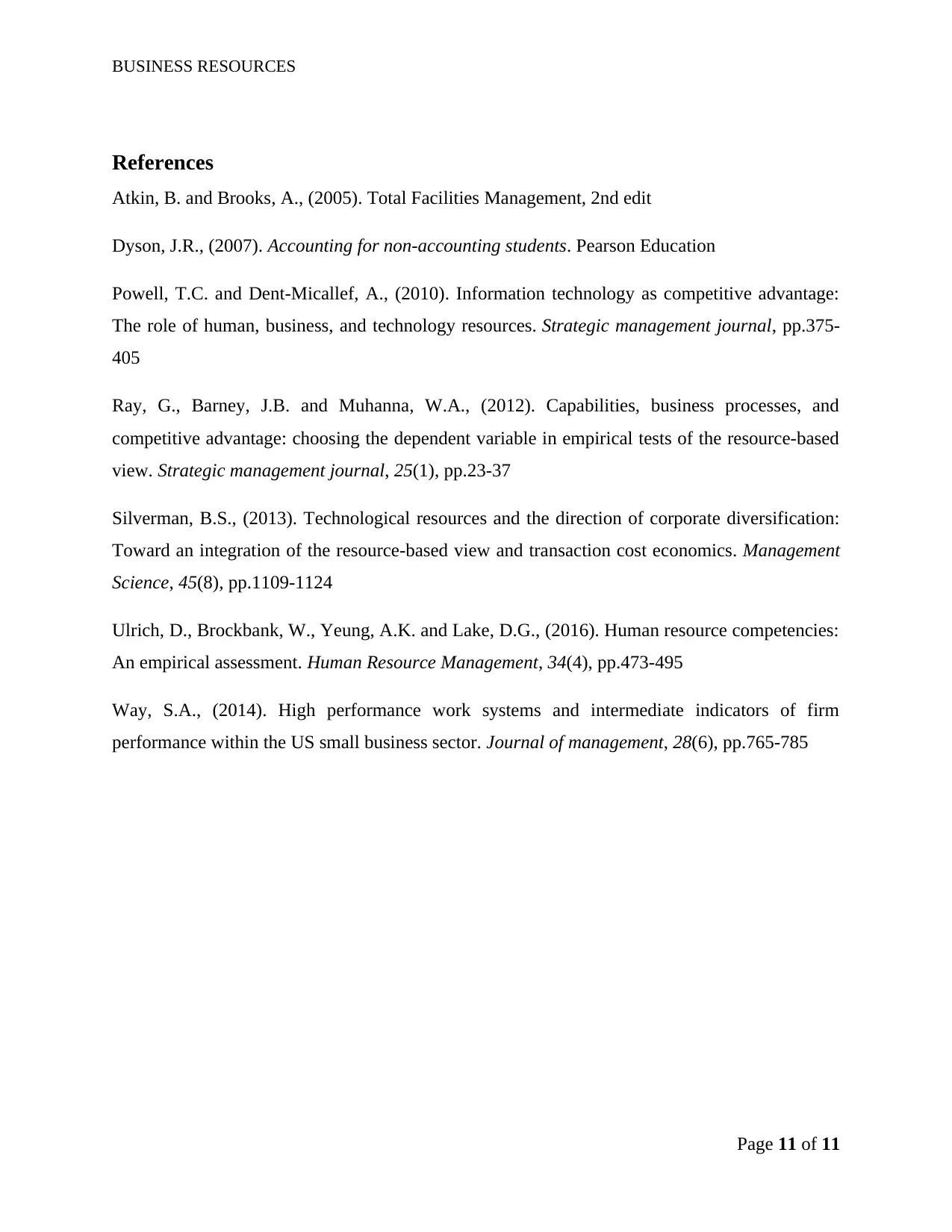
BUSINESS RESOURCES
References
Atkin, B. and Brooks, A., (2005). Total Facilities Management, 2nd edit
Dyson, J.R., (2007). Accounting for non-accounting students. Pearson Education
Powell, T.C. and Dent-Micallef, A., (2010). Information technology as competitive advantage:
The role of human, business, and technology resources. Strategic management journal, pp.375-
405
Ray, G., Barney, J.B. and Muhanna, W.A., (2012). Capabilities, business processes, and
competitive advantage: choosing the dependent variable in empirical tests of the resource‐based
view. Strategic management journal, 25(1), pp.23-37
Silverman, B.S., (2013). Technological resources and the direction of corporate diversification:
Toward an integration of the resource-based view and transaction cost economics. Management
Science, 45(8), pp.1109-1124
Ulrich, D., Brockbank, W., Yeung, A.K. and Lake, D.G., (2016). Human resource competencies:
An empirical assessment. Human Resource Management, 34(4), pp.473-495
Way, S.A., (2014). High performance work systems and intermediate indicators of firm
performance within the US small business sector. Journal of management, 28(6), pp.765-785
Page 11 of 11
References
Atkin, B. and Brooks, A., (2005). Total Facilities Management, 2nd edit
Dyson, J.R., (2007). Accounting for non-accounting students. Pearson Education
Powell, T.C. and Dent-Micallef, A., (2010). Information technology as competitive advantage:
The role of human, business, and technology resources. Strategic management journal, pp.375-
405
Ray, G., Barney, J.B. and Muhanna, W.A., (2012). Capabilities, business processes, and
competitive advantage: choosing the dependent variable in empirical tests of the resource‐based
view. Strategic management journal, 25(1), pp.23-37
Silverman, B.S., (2013). Technological resources and the direction of corporate diversification:
Toward an integration of the resource-based view and transaction cost economics. Management
Science, 45(8), pp.1109-1124
Ulrich, D., Brockbank, W., Yeung, A.K. and Lake, D.G., (2016). Human resource competencies:
An empirical assessment. Human Resource Management, 34(4), pp.473-495
Way, S.A., (2014). High performance work systems and intermediate indicators of firm
performance within the US small business sector. Journal of management, 28(6), pp.765-785
Page 11 of 11
1 out of 11
Related Documents
Your All-in-One AI-Powered Toolkit for Academic Success.
+13062052269
info@desklib.com
Available 24*7 on WhatsApp / Email
![[object Object]](/_next/static/media/star-bottom.7253800d.svg)
Unlock your academic potential
Copyright © 2020–2025 A2Z Services. All Rights Reserved. Developed and managed by ZUCOL.



